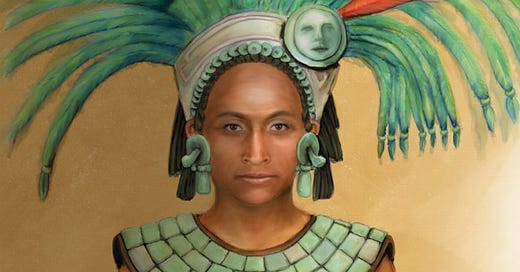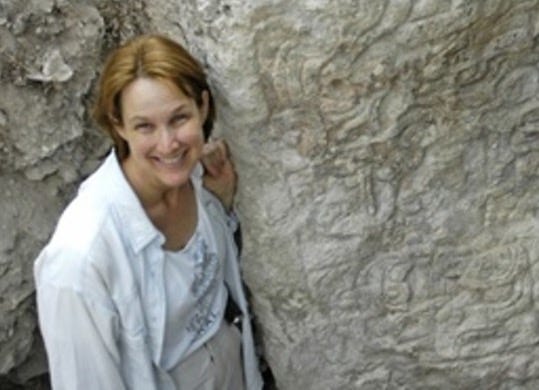Hola Amigos! What could be a more exciting topic than warrior queens? In a multi-part series, I delve into how they came to be recognized and why it took so long. On another note, I want to thank all of you, my subscribers, for being here, and my 1000th free subscriber, James Prevalett, who came on board two weeks ago. Mil gracias!
If your imagination ever wanders to women warriors, you don’t have to stop at Shuri of Wakanda fame or Amazonian princesses. Think about this: Maya warrior queens. Yes, they existed.
Their rise to power throughout the Maya world occurred after a geopolitical shift around 623 CE, when power repositioned into the forests of Yucatán’s central lowlands, according to a Discover1 article.
How did the archeological world first discover that Maya women rulers played a part in deciding their city-state's future? For three months in 2004, archeologist Kathryn Reese-Taylor, Associate Professor of Archeology, University of Calgary, along with an international research team, studied the great pyramids of Naachtun in the forests of northern Guatemala, one of the most inaccessible sites in the Maya world.
At the height of Maya civilization, this city sat between the Maya's two superpowers—Tikal and Calakmul. Reese-Taylor’s research is shining new light on evidence that a sizable contingent of warrior queens made a profound impact on their society in numerous areas: politics, culture, commerce and warfare, between 600 and 800 CE.
Her team mapped Naachtun's architecture and recorded ancient texts inscribed on altars and stela (large limestone slabs in front of pyramids). Stela 18 depicts a fierce Naachtun queen with a battle shield strapped to her arm, standing on the back of an enemy captive, a lord of Calakmul, a sign of complete surrender.
Thanks to Reese-Taylor's digging, this was the aha moment when the archeological conversation began to include women warriors, a concept that a decade earlier would have been dismissed. Until then, Maya royal women were pawns in marriage and/or consorts, mothers of kings. Nada mas. But her team's discovery changed all that, anchoring a position in archeology that accepted both women and men as powerful rulers in the Maya world.
The clothes they wear
Maya artists usually portrayed their kings trampling over cowering prisoners, but from Reese-Taylor's finds in Naachtun, the stela in question depicts both king and queen as conquerors. She continued to search for more documentation for proof, combing through hundreds of published inscriptions and royal portraits in university libraries in both US and Canadian archives.
Through collaboration with archeologist Peter Mathews, a fellow scholar at University of Calgary whose research specialized in the Naachtun site, she noted he had started to decode the subtleties of ancient Maya costumes. From him, Reese-Taylor learned the difference in clothing: Women warriors wore loose full calf-length skirts whereas men's clothing was tighter, more form fitting. Using that as a benchmark, she uncovered clothing differences in images of queens from several Maya cities beyond Naachtun. Her discoveries gave way to fact: the lowland Maya had many warrior queens, specifically in four Maya city-states: Coba, Naranjo, Calakmul and Naachtun.
As Reese-Taylor's on-site excavations continued to sort through more and more hieroglyphs, she determined the northern Maya dynasties prized their female ancestors. A northern royal family known as the Kaan, or Snake Dynasty, moved into mid-Peninsula Yucatán rain forests in the early 600s, claiming the throne from mighty Calakmul and rising to power. After 623 CE, Kaan princesses married into many local ruling houses in the lowlands, carrying these new ideas with them.
There was a "real expansion of the role women played in politics," said Reese-Taylor. "As I began researching, I noticed the existing literature suggested there were only a few isolated examples of these warrior queens in Maya society.
"But I started to realize that was bogus," Reese-Taylor continued. "There were, in fact, many examples of noble warrior women. Woman's role was not in the background. It was up front and center."
Asked why it took so long for women warrior rulers to be identified, Reese-Taylor stated her work in this area built on the findings of many researchers, including Traci Arden, University of Miami, Peter Mathews, and Maya scholar Linda Schele. (Schele died in April 1998). Through collaboration on findings, they discovered a quantum leap between 600 - 800 CE that depicted women warriors on royal monuments. She believes that earlier archeologists simply had yet to decipher the hieroglyphics needed to identify tell-tale signs, like the way women warriors dressed.
Many warrior queens
The first royal queen to hold a title was Lady Yohl Ik'nal, first woman recorded as ruler in the Maya kingdom and one of the few women who held this office. Her role was unusual because she held power for 21 years, from December 583 CE to November 604 CE and was known as a queen regnant, or official ruler of the city-state Baak/Baakal where Palenque was located as a city within it.
This is known because she had the title Divine Lord of Palenque and was its first woman ruler. Along with this distinction she supervised an "accession" for Lord K'an Tok. Historians believe this took place between 587 CE and 604 CE, her year of death.
Archeologist Merle Green Roberston thought her tomb was at Palenque in Temple XX. It's believed the queen was immortalized and referred to because of Pakal's famous sarcophagus, discovered untouched by archeologist Alberto Ruz in the 1950s. Maya artists depict prominent family members on tombs, and Lady Yohl Ik'nal was drawn twice, on the west side and east side, standing reborn by a zapote tree and also coming out of an avocado tree, reborn.
Palenque elevated Maya women rulers
Lady Yohl Ik’nal was related to K'uk' Balam who began his rule at Palenque in 431 CE and came to found a line of rulers, even though he had a short reign, lasting only four years till his death in 435 CE.
In Maya culture, women normally held temporary power through sons if they were too young to rule. The fact that Lady Yohl Ik'nal held power for more than two decades is impressive. She remained in power longer than her contemporaries in the region, withstanding two major attacks early on in her reign, the first in 599 CE from powerful Calakmul, and the second from Bonampak. In spite of defeats, she somehow retained her position and was treated with veneration throughout her reign.
Her name translates to Lady Heart of the Wind Place. Because her exact birth date is unknown, scholars believe she was either the daughter or sister of Palenque's Janaab Pakal, the previous ruler. As Maya rule usually descends through male lineage, historians have no doubt Palenque was going through a troubled time. There may have been unrecorded warfare that eliminated male candidates; this may have been the reason Lady Yohl Ik'nal ascended to the throne to become queen.
Pakal and his legacy
Though much remains unclarified, it's believed that her descendant K'inich Janaab Pakal—either grandson or great-grandson—became the greatest and most venerated of all Maya rulers, ruling for 68 years. Known simply as Pakal, his tomb was discovered in 1952 in the Temple of Inscriptions at Palenque.
Though Lady Yohl Ik'nal was the first to be discovered of Maya warrior queens, she was not the last.
Stay tuned for Part 2: More Maya queen warriors—Lady K’abel from the royal Maya city of El Perú-Waka’ and Lady Ikoom of the Snake Dynasty, Calakmul. These royal women, at first considered political pawns, were pawns no more.
Shannus Palus, Tasha Eichenseher. Discover. “The Power and the Glory of the Maya Queens.” February 2, 2014.
And if you’re interested in supporting independent journalism and writing, please consider a paid subscription to Mexico Soul. This is a free newsletter. I don’t paywall any of my posts, but you can choose to pay if you like what I deliver. It would mean the world to me and will keep you up to date on my posts and chapters from Where the Sky is Born—how we bought land and built a house in a small fishing village on the Mexico Caribbean coast. Not to mention a bookstore, too! All for $5/monthly or $50 per year.
If you enjoyed this article, please remember to hit the heart button to like it.
MY BACKSTORY—Puerto Morelos sits 100 miles from four major pyramid sites: Chichen Itza, Coba, Tulum and Ek Balam. Living in close proximity to this Maya wonderland made it easy to pyramid hop on our days off from Alma Libre Libros, the bookstore we founded in 1997. Owning a bookstore made it easy to order every possible book I could find on the Maya and their culture, the pyramids and the archeologists who dug at these sites and the scholars who wrote about them. I became a self-taught Mayaphile and eventually website publishers, Mexican newspapers and magazines, even guidebooks asked me to write for them about the Maya and Mexico. I’m still enthralled by the culture and history and glad there’s always new news emerging for me to report on right here on Mexico Soul.











Fascinating. So much to learn about this culture!
ALMA DE MEXICO FELICES Y GRACIAS